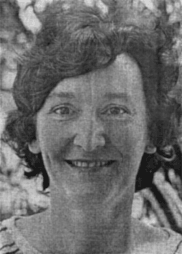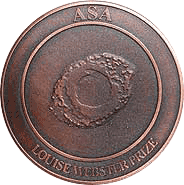
Louise Webster Prize
Dr Louise Webster completed her PhD on southern planetary nebulae at Mount Stromlo and went on to hold positions overseas before returning as a Commissioning Astronomer at the AAT and an inaugural staff astronomer at the AAO. In 1978 she joined the University of New South Wales, where she worked as an academic staff member until she passed away in 1990 at the age of 49, after a long illness. In addition to her outstanding research contributions in the fields of planetary nebulae and X-ray binaries, Louise was also passionate about the importance of mentoring her younger colleagues in the early stages of their research careers. A brief outline of Louise’s astronomical career has been written by John Storey and Don Faulkner (PASA, 1991, 9 (1), 6-7).

The Louise Webster Prize is awarded annually by the Astronomical Society of Australia in recognition of outstanding research by a scientist early in their post-doctoral career.
The Prize will be awarded based on the scientific impact of a single research paper, which has the nominee as first author. The research paper can be in any area of astronomy or a closely related field. The prize is intended for work carried out primarily after completion of a postgraduate degree.
The Prize consists of the Louise Webster Medal featuring the Helix Nebula (a planetary nebula), together with an award of $2,500 and ASA membership for the following calendar year. The recipient will be invited to present a paper on their research at the Annual Scientific Meeting of the Astronomical Society of Australia, where the prize will be presented.
Nominations for the 2025 Louise Webster Prize will open in December 2024 with a closing date of mid-February 2025.

Eligibility
- must have had their PhD conferred within five years* prior to the nomination deadline.
- must have published the nominated research paper in a refereed scientific journal, appearing in final published form within five years* prior to the nomination deadline.
- must have carried out research in an area of astronomy or closely related field.
- must be an Australian citizen or resident at the nomination deadline or, if not, the nominated research paper must have been published with affiliation to an Australian institution.
- must be a financial member of the ASA.
* Acceptable leaves of absence from active research will be taken into consideration when determining eligibility.
Nominations
- nominations can be submitted by a Department Head or colleague. Self-nominations are also acceptable.
- a letter of nomination up to 2 pages in length, outlining in a clear and concise manner the major scientific results in the research paper for which the nomination is made and the subsequent impact of the research paper.
- a copy of the first author research paper on which the nomination is based.
- a curriculum vitae including a complete list of publications.
- the names and email addresses of two professional astronomers who would be willing to write supporting letters for the nomination outlining their view of the scientific impact of the research paper. These referees cannot be co-authors on the research paper, but should be familiar with the nominee’s work.
Nominations should be emailed to the ASA Prizes and Awards Coordinator, Dr Tanya Hill – thill@museum.vic.gov.au.
An assessment committee nominated by the ASA Council will evaluate the nomination and make a recommendation to the ASA Council. The decision of the ASA Council is final, including a decision not to award the prize in any given year.
Limited travel funds to support attendance at the ASA Annual Scientific Meeting may be made available at the discretion of the ASA Council.
Previous Winners
- 2023 Joint Winner – Nichole Barry (Curtin University)
- “Improving the Epoch of Reionization Power Spectrum Results from MWA Season 1 Observations” Barry et al. 2019b, ApJ, 884, 1
- 2023 Joint Winner – Sven Buder (Australian National University)
- “The GALAH+ survey: third data release” Buder et al. 2021 MNRAS, 506, 150
- 2022 – Adam Stevens (University of Western Australia/ICRAR)
- “Atomic hydrogen in IllustrisTNG galaxies: the impact of environment paralleled with local 21-cm surveys” Stevens et. al. 2019, MNRAS, 483, 5334
- 2021 – Joseph Callingham (Netherlands Institute for Radio Astronomy)
- “Anisotropic winds in a Wolf-Rayet binary identify a potential gamma-ray burst progenitor” Callingham et. al. 2019, Nature Astronomy, 3, 82
- 2020 – Katie Auchettl (University of Melbourne)
- “New Physical Insights about Tidal Disruption Events from a Comprehensive Observational Inventory at X-Ray Wavelengths” Auchettl et. al. 2017, ApJ, 838, 149
- 2019 – Shivani Bhandari (Swinburne University)
- “The Survey for Pulsars and Extragalactic Radio Bursts – II. New FRB discoveries and their follow-up” Bhandari et al. 2018, MNRAS, 475, 1427
- 2018 – Emily Wisnioski (Australian National University)
- “The KMOS 3D Survey: Design, First Results, and the Evolution of Galaxy Kinematics from 0.7 < z < 2.7” Wisnioski et al. 2015, ApJ, Vol. 799, 209
- 2017 – Keith Bannister (CSIRO)
- “Real-time detection of an extreme scattering event: Constraints on Galactic plasma lenses” Bannister et al. 2016, Science, Vol. 351, Issue 6271, pp. 354-356
- 2016 – David Nicholls (Australian National University)
- “Resolving the electron temperature discrepancies in HII regions and planetary nebulae: κ-distributed electrons” Nicholls et al. 2012, ApJ, 752, 148
- 2015 – Madusha Gunawardhana (Macquarie University / AAO / University of Sydney)
- “Galaxy and Mass Assembly (GAMA): the star formation rate dependence of the stellar initial mass function” Gunawardhana 2011 MNRAS, 415, 167
- 2014 – Simon Campbell (Monash University)
- “Sodium content as a predictor of the advanced evolution of globular cluster stars” Campbell et al. 2013, Nature, 498, 198-200
- 2013 – Andrew Green (Swinburne University)
- “High star formation rates as the origin of turbulence in early and modern disk galaxies” Green et al. 2010, Nature, 467, 684
- 2012 – Sean Farrell (University of Sydney)
- “An Intermediate-mass black hole of over 500 solar masses in the galaxy ESO 243-49” Farrell et al. 2009, Nature, 460, 73
- 2011 – Gayandhi De Silva (Australian National University)
- “Chemically Tagging The HR 1614 Moving Group” De Silva et al. 2007, AJ, 133, 694
- 2010 – Michael Ireland (University of Sydney)
- “The Disk Around CoKu Tauri/4: Circumbinary, Not Transitional” Ireland, M.J. and Kraus, A.L. 2008, ApJ, 678, L59
- 2009 – Tamara Davis (University of Queensland / University of Copenhagen)
- “Scrutinizing exotic cosmological models using ESSENCE supernova data combined with other cosmological probes” Davis et al. 2007, ApJ, 666, 716-725

